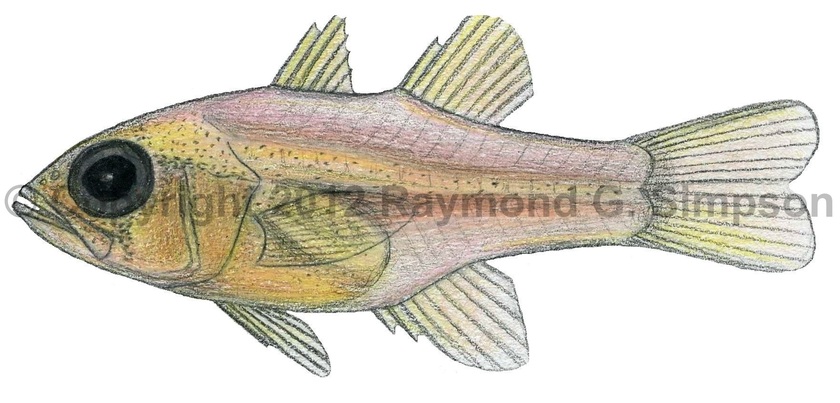
Common Name
Bridle Cardinalfish
Year Described
Mowbray, 1927
Identification
Dorsal Fin: VI, I-9
Anal Fin: II, 8
Pelvic Fin: I, 5
Pectoral Fin: 12
Gill Rakers: 4 upper, 10-11 lower
Vertebrae: 10 precaudal, 14-15 caudal
A small fish with a fairly robust and moderately compressed body. Eye is large and the snout short. Mouth is fairly large and oblique, with the lower jaw slightly protruding. Both jaws, palatine, and vomer with bands of villiform teeth (no canines). Preopercular edge with a slightly serrate margin. Preopercular flap extends to or slightly past the preopercular rear margin. There are two dorsal fins. The caudal fin is emarginate. Body scales ctenoid. Predorsal scales 5-6. Scales around the caudal peduncle 16-18.
Color
Variable from very pale to bright pink, orange-red, or salmon. Body translucent with peritoneum and vertebral column visible. Often displays two dusky bars radiating from the rear margin of eye (commonly missing or faint). Dorsum and side sprinkled with dusky melanophores. Fins vary from clear overall to displaying bright yellow bases and anterior margins/edges. Eye dark.
Size
Maximum size to 65mm SL.
Habitat
Found on coral reefs and in seagrass beds from 1-75m. Often found associated with sea anemones.
Range
S. Florida to northern S. America, including the Gulf of Mexico and the Caribbean Sea.
References
Gon, O. 2002. Apogonidae (pp 1386-1391). In: Carpenter. 2002. The living marine resources of the Western Central Atlantic. Vol. 3: Bony fishes part 2 (Opistognathidae to Molidae), sea turtles and sea mammals. FAO Species Identification Guides for Fisheries Purposes. American Society of Ichthyologists and Herpetologists Special Publication No. 5.
McEachran, J.D. & J.D. Fechhelm. 2005. Fishes of the Gulf of Mexico. Volume 2: Scorpaeniformes to Tetraodontiformes. University of Texas Press, Austin. i-viii +1-1004.